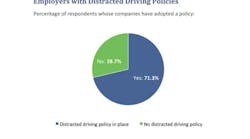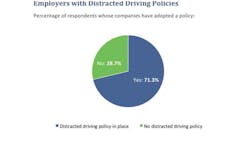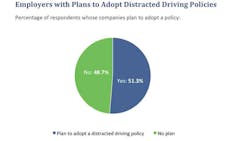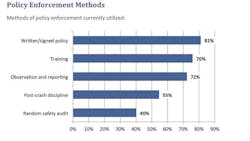According to the National Safety Council (NSC), April is the month to bring awareness to the problem of distracted driving. Coinciding with the month’s NSC theme, Aegis Mobility recently released the results of its third annual survey of commercial fleet operators and professional risk managers, which gauges corporate perspectives and attitudes toward employee use of mobile devices while driving on the job. The 2013 survey includes responses from 547 fleet safety and risk management professionals from different industries, including construction, utilities, and communications/cable.
Employers' concern about the risk and liability posed by employee use of mobile devices while driving on the job is at a three-year high. Seven out of 10 of the surveyed companies — 71.3% — have put in place written policies regulating distracted driving among employees. Of those that do not have a policy, more than half are planning to adopt one.“When we sent out the first survey three years ago, only a small subset of employers actually had policies,” says Matt Howard, chief marketing officer for Aegis Mobility, who in 2008 co-founded ZoomSafer, one of the first distracted driving platforms, which uses on-board diagnostics devices and telemetric systems integration. Aegis Mobility acquired the company in 2012. “When we started ZoomSafer, only about 16% or 17% of employers in the United States had some type of policy regarding their employees’ use of a mobile device while driving.”
What happened from 2009 to 2013 to drive awareness of the problem of distracted driving? The media picked up on it, says Howard. “Oprah went on the air and did her thing with regard to distracted driving,” he says. “Every newspaper in America has had a front page story about teenagers killing themselves by texting while driving.”
In addition, Howard continues, laws have been passed by federal agencies, such as the Federal Motor Carrier Safety Administration. In fact, 38 states have passed distracted driving legislation.
“If you read the papers or pay moderate attention to what’s going on in state legislation, you’ve got it staring you in the face,” says Howard. “It’s become something that more and more people — both consumers and employers — have become aware of.”
Awareness doesn’t necessarily mean compliance.
Although the survey reveals that 85.7% of the companies with distracted driving plans are attempting to enforce them, only 32.3% are very confident that their current enforcement methods are effective at achieving compliance. Less than two-thirds of the respondents with policies are somewhat confident that enforcement methods are effective. The most common methods of enforcing the policy are written/signed contracts, training, observation and reporting, post-crash discipline, and random safety audits.
“Just because people are aware of the repercussions of distracted driving doesn’t mean they modify their behavior,” says Howard, citing a study by the Insurance Institute for Highway Safety of crash statistics in the wake of the hands-free device legislation in California that found the number of claims and crashes in the state had actually increased one year after the legislation took effect.“What the Insurance Institute surmised was that the law didn’t actually stop people from texting and emailing while driving,” he continues. “What the law really did was to force people to do it more surreptitiously. Basically, they were keeping the phone below the window and holding it closer to their knee so they could avoid the ticket. This was exacerbating the level of cognitive, visual, and physical distraction associated with the task and increasing the likelihood of a crash.”
Furthermore, the danger of distracted driving is expected to increase as the on-the-job use of smart phones and tablets increases. A study from EMA Contractors, a specialty group at Eric Mower + Associates, reveals contractors’ use of smart phones while on the job increased 35% from 2011 to 2012. In addition, the report, “Connecting with Contractors,” which surveyed 200 U.S. general contractors, electricians, plumbers, and HVAC specialists, revealed contractors’ use of tablets rose nearly 54% in that same time period. Overall, 22% of contractors were using tablets in 2012, and 68% of contractors surveyed said they use smart phones as part of their workday. “Smartphone and tablet use among contractors on the job site continues its dramatic rise,” said John O’Hara, EMA partner and leader of EMA Contractors.
According to the EMA Contractors survey, increased technology device usage is being driven mostly by convenience and productivity, as smart phones and tablets allow contractors to stay connected with coworkers, distributors, and vendors/subcontractors; increase productivity; and save time while on the job. Being able to check specifications, compare products, and prices were also important. Another driver is the need for contractors to have more information available to them quickly. Of all contractors, electricians consIt’s likely, according to Aegis Mobility, that these employees are performing these tasks while on the road. The firm performs cell phone safety audits for companies, and often finds that driving logs and mobile device bills contain damning evidence. In one 2011 audit, Aegis Mobility professionals examined 60 days’ worth of driving data alongside the same 60 days’ worth of cell phone billing records for 10% of a company’s employees. (The Blackberries were issued by the company, so no legal paperwork was required for the billing information).
“We had an empirical record going back to when those vehicles were driven, what time of day, and by whom,” says Howard. “We mashed it up, correlated the data, and gave them the answer, which was 95% of the employees at this company violated the policy not once per day but five and a half times per day.”
What the research shows, again and again, is that despite awareness of the danger and even penalties from employers, workers continue to use their mobile devices while they drive.
“It’s very difficult to put the phone down,” says Howard. “There’s this constant connectedness in our modern society that makes it very difficult for people not to look at their phones. So even if a company has in place a policy against distracted driving and has done training, its employees probably are not in compliance. The results of these audits are all the same. People don’t comply. Telling somebody not to do this is not sufficient to change the behavior.”
Zero tolerance policies.
However, it’s still early days for distracted driving policies, and companies have yet to fully experience the negative effects of distracted driving. But the increased prevalence of lawsuits and higher insurance premiums are tipping the balance on the bottom line.
“The reality is, if there’s a financial implication to their bottom line, you’ll get their attention faster,” says Howard. “Safety is definitely a component, but the practical reality is that if all you do is put a policy on a piece of paper and expect it to actually protect you from risk and liability, you’re wrong. If that’s all you do,So employers shouldn’t just give up on the idea of fostering safe driving practices. Instead, they should consider taking additional steps, including a zero-tolerance policy that comes from their safety divisions.
“Don’t get me wrong, I think some of this works,” says Howard. “There is a legitimate effort being made by employers to enforce compliance of some of these policies, and some of this moves the needle and results in employers taking disciplinary action against employees who violate the policy. But the next question that needs to be asked is, ‘Do we have any confidence that efforts are actually modifying employee driving behavior?’”
The impetus for safer driving practices has to come from the top down. Employers are going to have to sacrifice the productivity benefit gained by quicker response from mobile devices on the road for lowering the risk associated with that behavior.
“We have seen situations where employers have essentially said that the value of mobile productivity is greater to my bottom line,” says Howard. "It’s a trade-off some are willing to make. It’s a business decision. But it’s a bad one if what you want is to maximize safety and minimize risk.”
Because many firms in the construction industry already foster a culture of safety, they are most likely to be successful in implementing a zero-tolerance policy for distracted driving.
“Construction companies are serious about safety, because in their world, when people make mistakes about safety, people get hurt or die,” says Howard. “As a construction industry employer, you have an obligation to create a safe workplace environment, and that also includes not requiring your employees to use a mobile device while driving. Construction employers are slowly but surely — certainly the safety people we talk to —becoming spiritually aligned with us. They get it. We’re talking each other’s language.”
Construction firms are already familiar with fleet management systems that track fuel consumption and routes. A logical extension of those devices is to include an anti-distracted driving application. There are various types, including hands-free and on-dashboard, although the National Safety Council advises against all mobile device use behind the wheel.
“From a safety perspective, you’d say no calls at all — zero tolerance,” says Howard. “But if you’re trying to balance the need for improved safety with the need for mobile connectivity for productivity, you might go with a hands-free system.”
Howard estimates that of the 18 million fleet vehicles in the United States, around five or six million have some type of tracking or telemetric device in the vehicle to provide the employer information about location, speed, and fuel consumption.
“The market is penetrated by less than a third, but that’s still five million vehicles” says Howard. “Those employers have come to a decision that it’s in their financial interest to monitor and measure employee behavior with regard to the big brake pedal, the steering wheel, and the gas pedal. These same employers will eventually come to the conclusion that it’s also important that they monitor employee behavior as it relates to mobile device use. If you give your employees a tablet computer, you cannot let them be playing Angry Birds while driving the company vehicle. You can’t let that happen.”







